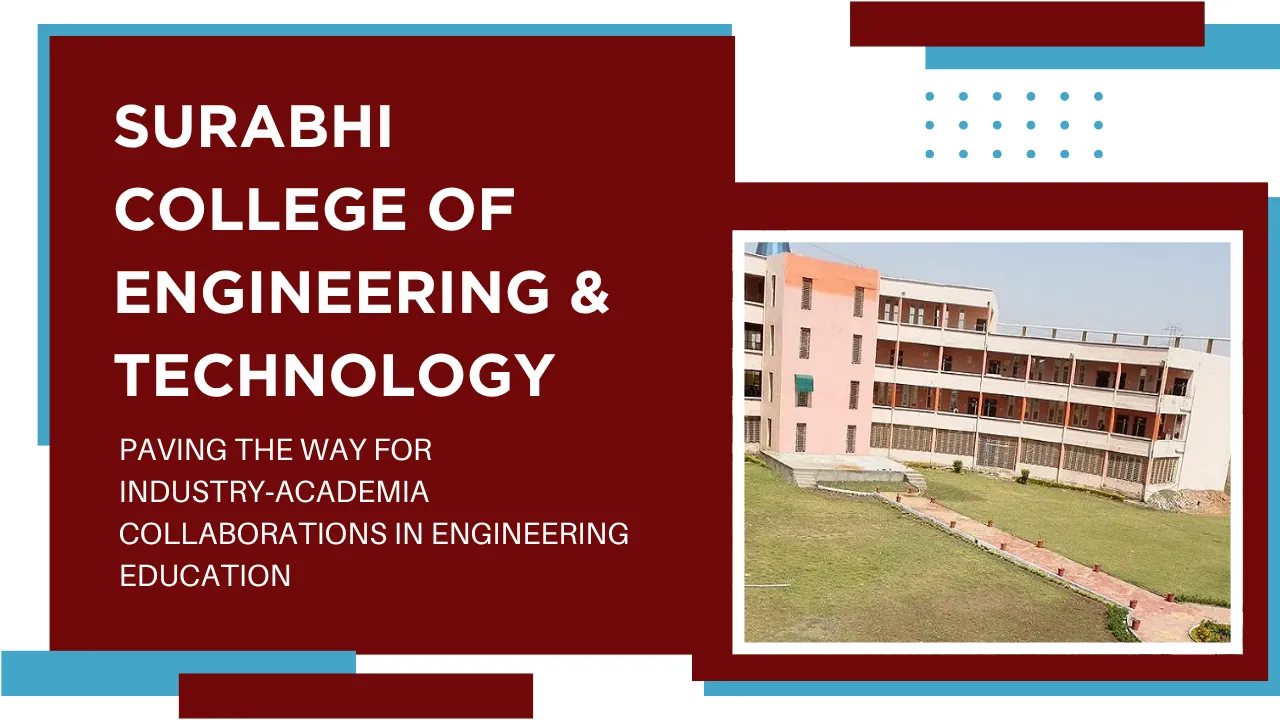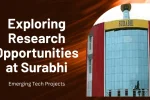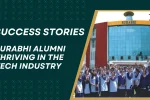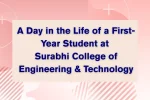Surabhi College of Engineering & Technology: Surabhi College of Engineering & Technology has emerged as a brilliant model of how industry‑academia collaborations can turbocharge students’ skill development. In today’s fast-paced world of automation, artificial intelligence, and emerging technologies, the need for hands-on learning is greater than ever. Surabhi stands out by forging real-world partnerships that bring theory to life, equipping students with practical experience and a competitive edge.
This article examines how Surabhi College of Engineering & Technology builds meaningful connections with businesses. You will discover the frameworks behind live projects, certifications, faculty training, and mentorships. We’ll explore how these efforts boost student employability, foster innovation, and strengthen the local tech ecosystem—all while maintaining academic excellence.
Surabhi College of Engineering & Technology — A Unique Industry‑Academia Interface
At Surabhi College of Engineering & Technology, industry-academia collaboration is not an afterthought—it’s a central pillar of the learning experience. The college brings in partner companies to co-create curriculum-aligned internships, hackathons, and certification programs. Students work on real-life engineering challenges under mentors from software firms, manufacturing units, and startups. Beyond technical learning, they gain soft skills like teamwork, problem-solving, and communication. Faculty members benefit too by staying current in cloud computing, the Internet of Things, embedded systems, and data analytics. This immersive, multi-stakeholder model ensures learners graduate job-ready and innovation-driven.
1. Why Industry‑Academia Collaborations Matter
In fast-evolving fields like robotics and cybersecurity, just learning from textbooks isn’t enough. The gap between classroom knowledge and actual industry needs is widening. At Surabhi College of Engineering & Technology, collaborations bridge this gap by offering:
- Hands-on engineering experience through real projects and labs
- Understanding of current technologies such as IoT, artificial intelligence, and cloud solutions
- Access to latest tools and software that academic labs may lack
- Exposure to startup culture and established industries for diverse career insight
As a result, students finish their degree with practical skills, robust portfolios, and strong confidence.
2. Key Collaboration Models at Surabhi
a) Industry‑Led Projects and Internships
Surabhi partners with tech companies to offer semester-long internships and capstone projects. Students work in teams on tasks such as developing software modules, building embedded systems prototypes, or creating data analytics pipelines. Each team receives guidance from company mentors, enhancing their technical competence and project management skills.
b) Guest Lectures and Masterclasses
Every semester, experts from aerospace, semiconductor, renewable energy, and IT companies join Surabhi to deliver interactive sessions. These masterclasses cover trending areas like blockchain, machine learning, and cybersecurity—offering students up-to-date knowledge and real-world case studies.
c) Faculty Training and Certification
To stay aligned with industry trends, Surabhi organizes training sessions and certifies faculty in cloud platforms (AWS, Azure), networking (Cisco), and programming (Python, Java). Trained professors infuse fresh insights into classroom teaching, keeping the curriculum relevant.
d) Research Collaborations and Innovation Challenges
Surabhi hosts hackathons and innovation events alongside partners from fintech, agritech, and automotive sectors. Teams of students and faculty compete to solve real-world issues—such as smart agriculture sensors or predictive maintenance tools—encouraging creativity and entrepreneurial thinking.
3. Structure and Implementation
Surabhi’s robust framework is anchored by its dedicated Industry Liaison Cell. This team handles:
- Identifying strategic industry partners
- Aligning project themes with course learning outcomes
- Scheduling internships, guest talks, and training during semester breaks
- Ensuring lab resources and hardware are available
- Collecting feedback from students, faculty, and companies
This structured approach ensures seamless coordination and measurable outcomes.
4. What Students Gain
a) Practical Experience
Rather than pure theory, students tackle real engineering challenges. From coding enterprise-level systems to designing electronics, their portfolios become project-rich and employer-ready.
b) Soft‑Skill Development
Collaborations require teamwork, client communication, presentation skills, and adaptability. These transferable “people skills” are vital in multidisciplinary work environments.
c) Professional Networking
As students engage with mentors and company representatives, they build relationships that often lead to internship offers or job referrals. Exposure to company culture and organizational expectations gives them clarity on career paths.
d) Certifications and Tools Exposure
Through training experiences, students earn industry-recognized credentials—such as AWS Practitioner, Cisco CCNA, or Autodesk certifications—that boost their résumés and market value.
5. Success Stories
IoT‑Enabled Environmental Monitoring
Final-year students at Surabhi designed sensor-based environmental monitoring systems. Deployed in a nearby town, these systems track air quality and water levels. The project earned them job offers from partner firms and the grant of a startup incubator.
AI-Powered Manufacturing Quality Control
In collaboration with a local manufacturing company, a team developed an AI image-recognition system to inspect product defects. The system won a regional engineering award and piqued the interest of industry associations.
6. List of Two Key Partnership Types
- Live Internship Programs
- Hackathons & Innovation Challenges
7. Challenges and Solutions
Aligning Skill Levels
Projects can overwhelm students if requirements are too advanced. Surabhi matches project complexity to academic level and provides mentorship to support learning.
Timing Conflicts
Industrial schedules may clash with academic calendars. The Industry Liaison Cell coordinates flexible timelines to fit semester breaks or weekends.
Sustaining Engagement
Companies want long-term benefits. Surabhi maintains transparent feedback, publishes partnership outcomes, and highlights success stories to motivate continual collaboration.
8. Feedback from Students and Professors
“Collaborating with an industry mentor taught me to think like an engineer, not just a student,” says final-year student Priya.
“Our faculty stays updated on cloud computing and modern software methods, which enriches our classroom teaching,” adds Prof. Rao, HOD of ECE.
These testimonials reflect the potent impact of Surabhi’s collaboration strategy.
FAQs
1. How are students chosen for internships and projects?
Selections are based on academic performance, interest, and relevant skills. Students often submit applications and go through short interviews with company mentors.
2. Do all majors get equal access to industry partnerships?
Yes. Surabhi offers collaborations across departments—Mechanical, Civil, Computer Science, ECE, and more—with partners in varied domains like robotics, renewable energy, and fintech.
3. Are students paid during internships?
Some are stipend-based, while others offer academic credit. Companies often provide certificates or letters of recommendation after successful completion.
4. How is the curriculum updated using industry input?
The Industry Liaison Cell collects feedback and designs training modules in collaboration with industry partners. This helps professors introduce new topics and case studies into coursework.
5. Do alumni stay involved after graduation?
Absolutely. Surabhi keeps alumni engaged as mentors, guest lecturers, and hiring partners. They also help promote collaboration and encourage donations to labs or scholarships.
Final Thought & Call to Action
Surabhi College of Engineering & Technology delivers a forward-thinking education model that bridges academics and industry through real-world projects, internships, workshops, and certifications. Students graduate not just with degrees, but with hands-on engineering experience, professional networks, industry credentials, and confidence to tackle challenges in automation, AI, IoT, and beyond.
If this story inspired you, share it with fellow students, educators, and industry friends. Comment below with your questions or ideas—let’s keep this conversation going. And if you’re considering how to boost your career in engineering, visit our website to learn about upcoming hackathons, mentorships, and scholarship programs. Discover more, engage with our community, and take your first step toward the future!






